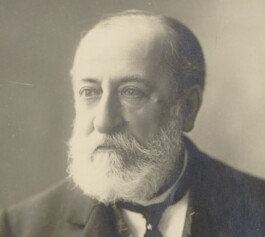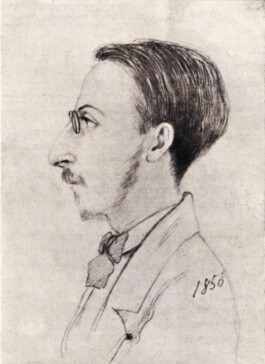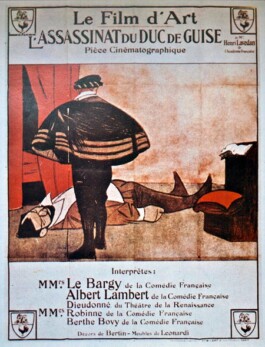


16th december 2021
On 16 December 1921 Camille Saint-Saëns (1835-1921) passed away. This musical genius gave his first piano concert at the age of eleven at the Salle Pleyel. He played Mozart and Beethoven. Saint-Saëns' greatest works include the opera "Samson et Dalila", "La danse macabre" and the symphonic suite "Le carnaval des animaux". This major work was premiered on 9 March 1886 and performed on 2 April 1886 in Paris by the cellist Charles Lebouc and the composer and singer Pauline Viardot, whose bicentenary is being celebrated this year. Here are six facts about his life, whether significant, anecdotal or little known.

Portrait of Camille Saint-Saëns, 1900-1910. Gallica-BnF
1- He was also a writer. Saint-Saëns wrote a book on astronomy, Problèmes et mystères, published in 1894 by Flammarion. This great musician also wrote verses, comedies and several works on the fourth art.
2- He was a friend of Pauline Viardot (who drew him, image opposite), but also of Hector Berlioz, Charles Gounod, Gioachino Rossini and Franz Liszt. He also dedicated a poem to "Madame Pauline Viardot ".

3- One of the most famous French musicians in the world. He became so through his career as a composer and pianist. Camille de Saint-Saëns created and performed works in France and abroad. Thus, Symphony No. 3 with organ was premiered in London in 1886 and Samson et Dalila was performed for the first time in Weimar in 1877.
4- A career of remarkable longevity. For almost 80 years, he performed in thousands of concerts throughout the world. Saint-Saëns played the piano, the organ and worked as a conductor. He performed his own works as well as those of other composers, both past and present.
5- He wrote the first film music and is included in the credits. Saint-Saëns composed the music for the film directed by André Calmettes and Charles Le Bargy, The Assassination of the Duke of Guise in 1908. At a time when cinema was silent, his 'soundtrack' was played live during film screenings.

6- A national funeral was organised by the government after his death in Algiers. It was celebrated on 24 December 1921 in the Madeleine church in Paris. His remains were buried the same day in the Montparnasse cemetery.
*« À Madame Pauline Viardot »
Gloire de la Musique et de la Tragédie,
Muse qu'un laurier d'or couronna tant de fois,
Oserai-je parler de vous, lorsque ma voix
Au langage des vers follement s'étudie ?
Les poètes guidés par Apollon vainqueur
Ont seuls assez de fleurs pour en faire une gerbe
Digne de ce génie éclatant et superbe
Qui pour l'éternité vous a faite leur sœur.
Du culte du beau chant prêtresse vénérée,
Ne laissez pas crouler son autel précieux,
Vous qui l'avez reçu comme un dépôt des cieux,
Vous qui du souvenir êtes la préférée !
Ah ! Comment oublier l'implacable Fidès
De l'amour maternel endurant le supplice,
Orphée en pleurs qui pour revoir son Eurydice
Enhardi par Éros pénètre dans l'Hadès !
Grande comme la Lyre et vibrante comme elle,
Vous avez eu dans l'Art un éclat nonpareil
Vision trop rapide, hélas ! Que nul soleil
Dans l'avenir jamais ne nous rendra plus belle !
16th december 2021
On 16 December 1921 Camille Saint-Saëns (1835-1921) passed away. This musical genius gave his first piano concert at the age of eleven at the Salle Pleyel. He played Mozart and Beethoven. Saint-Saëns' greatest works include the opera "Samson et Dalila", "La danse macabre" and the symphonic suite "Le carnaval des animaux". This major work was premiered on 9 March 1886 and performed on 2 April 1886 in Paris by the cellist Charles Lebouc and the composer and singer Pauline Viardot, whose bicentenary is being celebrated this year. Here are six facts about his life, whether significant, anecdotal or little known.

Portrait of Camille Saint-Saëns, 1900-1910. Gallica-BnF
1- He was also a writer. Saint-Saëns wrote a book on astronomy, Problèmes et mystères, published in 1894 by Flammarion. This great musician also wrote verses, comedies and several works on the fourth art.
2- He was a friend of Pauline Viardot (who drew him, image opposite), but also of Hector Berlioz, Charles Gounod, Gioachino Rossini and Franz Liszt. He also dedicated a poem to "Madame Pauline Viardot ".

3- One of the most famous French musicians in the world. He became so through his career as a composer and pianist. Camille de Saint-Saëns created and performed works in France and abroad. Thus, Symphony No. 3 with organ was premiered in London in 1886 and Samson et Dalila was performed for the first time in Weimar in 1877.
4- A career of remarkable longevity. For almost 80 years, he performed in thousands of concerts throughout the world. Saint-Saëns played the piano, the organ and worked as a conductor. He performed his own works as well as those of other composers, both past and present.
5- He wrote the first film music and is included in the credits. Saint-Saëns composed the music for the film directed by André Calmettes and Charles Le Bargy, The Assassination of the Duke of Guise in 1908. At a time when cinema was silent, his 'soundtrack' was played live during film screenings.

6- A national funeral was organised by the government after his death in Algiers. It was celebrated on 24 December 1921 in the Madeleine church in Paris. His remains were buried the same day in the Montparnasse cemetery.
*« À Madame Pauline Viardot »
Gloire de la Musique et de la Tragédie,
Muse qu'un laurier d'or couronna tant de fois,
Oserai-je parler de vous, lorsque ma voix
Au langage des vers follement s'étudie ?
Les poètes guidés par Apollon vainqueur
Ont seuls assez de fleurs pour en faire une gerbe
Digne de ce génie éclatant et superbe
Qui pour l'éternité vous a faite leur sœur.
Du culte du beau chant prêtresse vénérée,
Ne laissez pas crouler son autel précieux,
Vous qui l'avez reçu comme un dépôt des cieux,
Vous qui du souvenir êtes la préférée !
Ah ! Comment oublier l'implacable Fidès
De l'amour maternel endurant le supplice,
Orphée en pleurs qui pour revoir son Eurydice
Enhardi par Éros pénètre dans l'Hadès !
Grande comme la Lyre et vibrante comme elle,
Vous avez eu dans l'Art un éclat nonpareil
Vision trop rapide, hélas ! Que nul soleil
Dans l'avenir jamais ne nous rendra plus belle !


Playlist